2500 Years Dwarkadhish Temple: Where Miracles Still Happen
The Dwarkadhish Temple is a Hindu temple dedicated to Lord Krishna, the eighth incarnation of Vishnu. It is located in the city of Dwarka, Gujarat, India. The temple is one of the four Dhams, or holiest pilgrimage sites in Hinduism. The temple is dedicated to Lord Krishna, who is worshipped here in his Dwarkadhish form, or “King of Dwarka.”
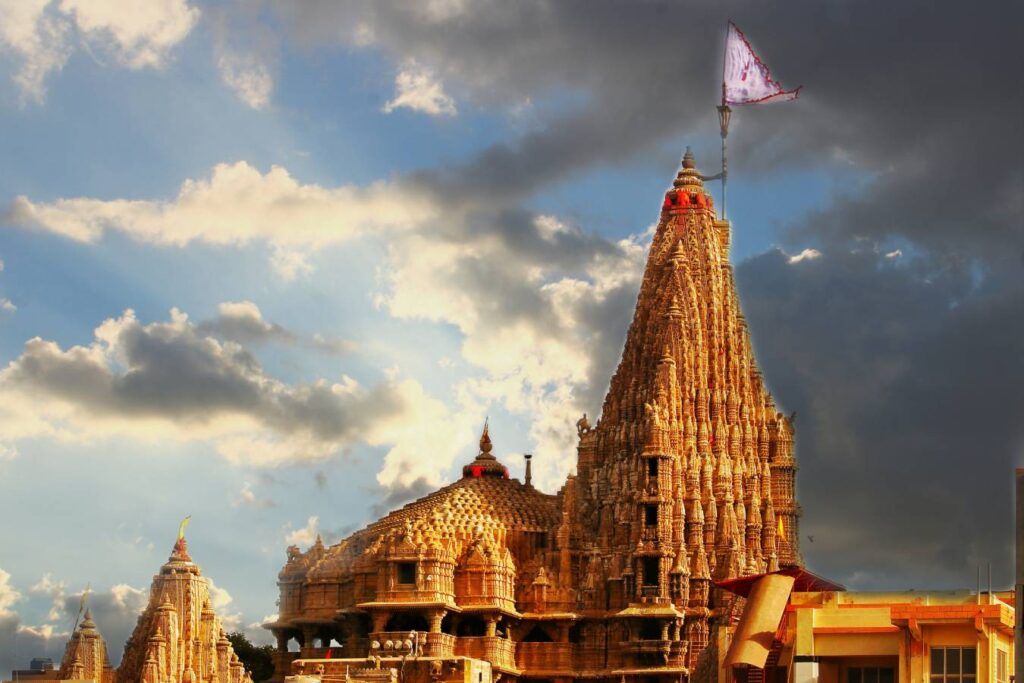
द्वारकाधीशं कृष्णं जगदीश्वरं देवं,नमामि चरणौ भक्तिसमुद्रमग्नम् ।सर्वदुःखहरणं सर्वमंगलं देवं,भजे द्वारकाधीशं कृष्णं नित्यं मनसा ॥
Dvārakādīśam Kṛṣṇam jagadīśvaram devam,Namāmi caraṇau bhakti-samudra-magnaṃ ।Sarva-duḥkha-haraṇam sarva-maṅgalaṃ devam,Bhaje Dvārakādīśam Kṛṣṇam nityaṃ manasā ॥
Translation:
I bow to the lotus feet of Lord Krishna, the Lord of Dwarka, the Lord of the universe, who is immersed in an ocean of devotion. I worship Lord Krishna, the Lord of Dwarka, who removes all suffering and bestows all auspiciousness, with my mind always.
This sloka is often chanted by devotees of Lord Krishna, especially those who are visiting the Dwarkadhish Temple in Dwarka. It is a beautiful and powerful sloka that expresses the deep devotion and love that devotees feel for Lord Krishna.
Contents
- 1 History of Dwarkadhish Temple:
- 2 Significance of Dwarkadhish Temple:
- 3 Legend of Dwarkadhish Temple:
- 4 Myths of Dwarkadhish Temple:
- 5 Dwarkadhish Temple Timing:
- 6 Architecture of Dwarkadhish Temple:
- 7 Specialty of Dwarkadhish Temple:
- 8 Mystery of Dwarkadhish Temple:
- 9 Secrets of Dwaraka:
- 10 Archaeological findings in Dwaraka:
- 11 Places to visit near Dwarkadhish Temple:
- 12 FAQ:
- 13 How to reach Dwarkadhish Temple:
- 14 Google Maps:
History of Dwarkadhish Temple:
The history of the Dwarkadhish Temple is long and complex, with the original temple believed to have been built over 2,500 years ago. According to local beliefs, the temple was built by Lord Krishna’s great grandson Vajranabha in honour of the Lord. The original temple had an umbrella-like structure and an idol of Lord Krishna, according to the temple administration.
Over the centuries, the temple has been destroyed and rebuilt several times. Archaeological findings suggest the original temple was built in 200 BCE at the earliest, and the current temple dates back to the 15th–16th century. The temple was rebuilt and enlarged during this time period in the Māru-Gurjara style.
The Dwarkadhish Temple is a five-storey building with a 43-metre spire. The main shrine of the temple houses the idol of Lord Krishna, which is made of black marble. The idol is dressed in different clothes and jewellery every day, and the temple is known for its elaborate rituals and festivals.
The Dwarkadhish Temple is one of the most popular pilgrimage sites in India, and attracts millions of visitors every year. It is a sacred place for Hindus, and is also a popular tourist destination.
Here is a timeline of the history of the Dwarkadhish Temple:
- 200 BCE: The original temple is believed to have been built by Vajranabha, Lord Krishna’s great grandson.
- 413 AD: The temple is reconstructed during the Gupta dynasty.
- 1472: The temple is destroyed by Mahmud Begada, the Sultan of Gujarat.
- 15th–16th century: The temple is rebuilt and enlarged in the Māru-Gurjara style.
- 18th century: The temple is renovated by the Scindia dynasty of Gwalior.
- 19th century: The temple is further renovated and embellished.
- 20th century: The temple becomes a popular pilgrimage and tourist destination.
Explore More Temples>> Virat Shakti Peeth | Ambika Shaktipeeth
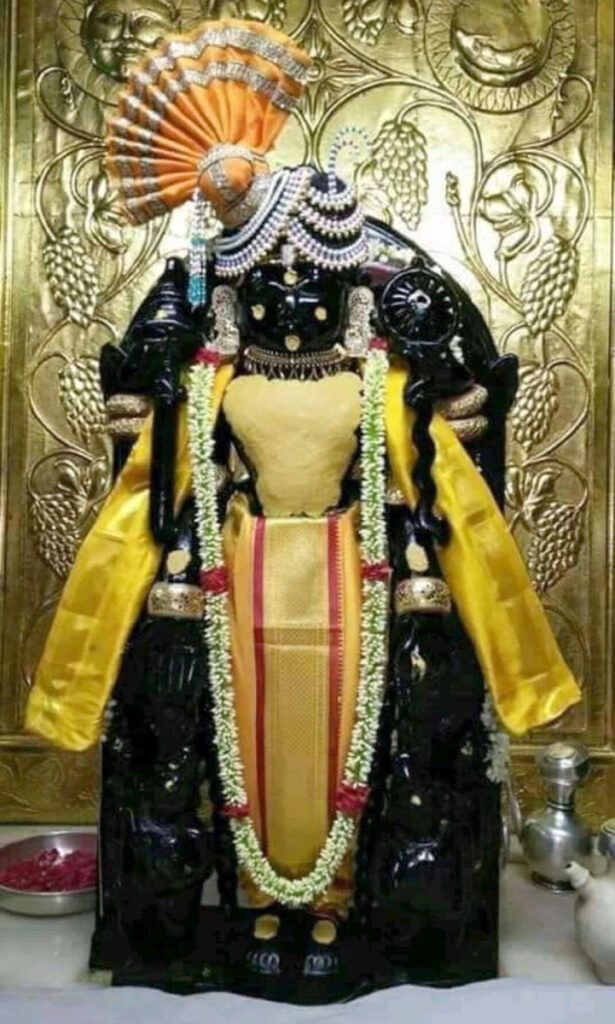
Significance of Dwarkadhish Temple:
The Dwarkadhish Temple is believed to have been built over 2,500 years ago by Vajranabha, Krishna’s great grandson. The original temple was destroyed several times over the centuries, but was rebuilt each time. The current structure dates back to the 16th century.
The Dwarkadhish Temple is a massive structure, with a seven-storeyed main shrine and over 70 smaller shrines. The temple is known for its intricate architecture and its beautiful sculptures. The main shrine houses a black stone idol of Lord Krishna, which is said to be over 2,000 years old.
The Dwarkadhish Temple is a significant pilgrimage site for Hindus for a number of reasons. First, it is one of the four Char Dham sites, which are considered to be the most sacred pilgrimage sites in Hinduism. Second, the temple is associated with Lord Krishna, who is one of the most popular and revered deities in Hinduism. Third, the temple is believed to be built over the site of Krishna’s ancient kingdom of Dwarka.
Every year, millions of Hindu pilgrims from all over India and the world visit the Dwarkadhish Temple. The temple is especially popular during the Janmashtami festival, which celebrates Krishna’s birthday.
Explore More Temples>> Gayatri Shaktipeeth Chitrakoot Temple
Legend of Dwarkadhish Temple:
The legend of the Dwarkadhish Temple is closely intertwined with the story of Lord Krishna, one of the most popular and revered deities in Hinduism. According to the Mahabharata, Krishna established his kingdom of Dwarka on a piece of land that he reclaimed from the sea. The Dwarkadhish Temple is said to have been built on the site of Krishna’s palace, and the main idol in the temple is believed to be over 2500 years old.
One of the most popular legends associated with the Dwarkadhish Temple is the story of how Krishna brought the river Ganga to Dwarka. According to legend, Krishna’s wife Rukmini was once feeling thirsty, so Krishna dug a hole in the ground with his toe and summoned the Ganga River. The water that flowed out of the hole is said to be still present in the temple today, and it is considered to be very sacred.
Another legend tells the story of how the original Dwarkadhish Temple was destroyed by Mahmud Begada, the Sultan of Gujarat, in 1472. The temple was later rebuilt, but it is said that the original idol of Krishna was saved by a devotee named Vallabha Acharya. Vallabha Acharya hid the idol in a well, where it remained hidden for many years. The idol was eventually rediscovered and reinstalled in the Dwarkadhish Temple in the 16th century.
The Dwarkadhish Temple is one of the most important Hindu pilgrimage sites in India. It is one of the four Char Dham pilgrimage sites, which are considered to be the most sacred places for Hindus to visit. The temple is also one of the 12 Jyotirlinga temples, which are dedicated to the supreme deity Shiva.
Explore More Temples>> Kankalitala Shakti Peeth Temple
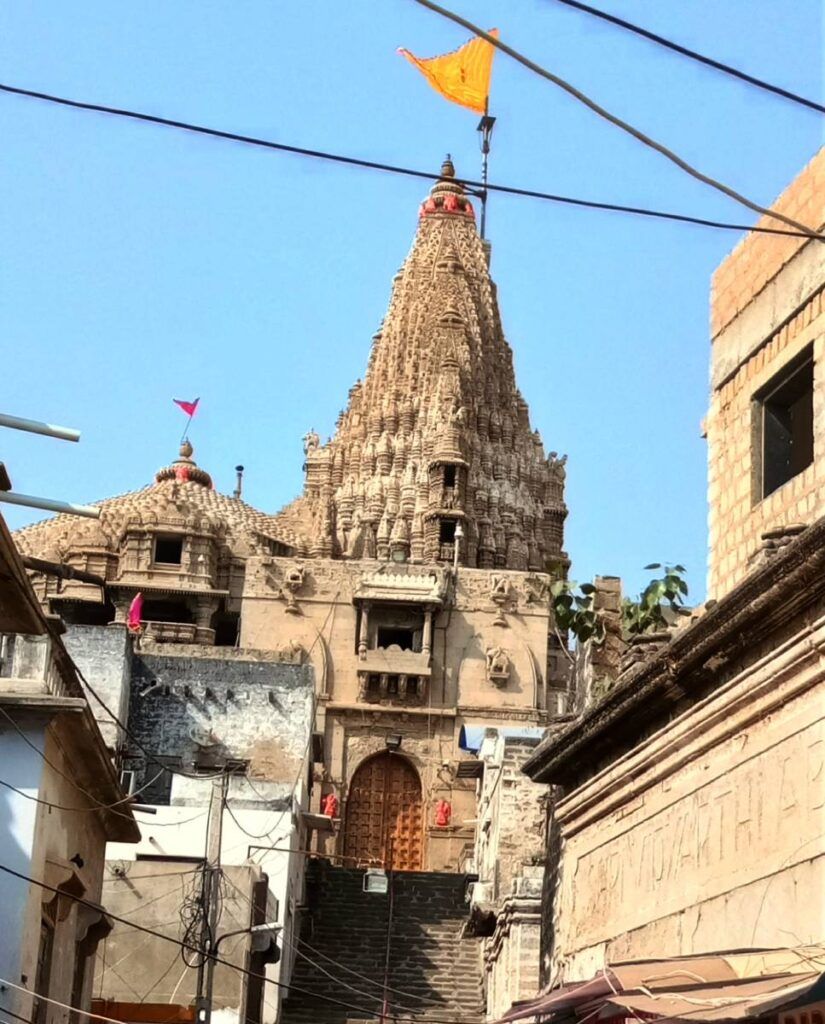
Myths of Dwarkadhish Temple:
The temple is associated with a number of myths and legends. One of the most popular myths is that the original city of Dwarka was submerged into the sea seven times. The current city of Dwarka is believed to be the seventh and final incarnation of the city.
Another myth is that the Dwarkadhish Temple was originally built by Lord Krishna’s great grandson, Vajranabha. However, the temple has been rebuilt and renovated several times over the centuries. The current structure dates back to the 16th century.
One of the most interesting myths about the Dwarkadhish Temple is the story of the sage Durvasa. According to legend, Durvasa once visited Krishna and his wife Rukmini. The sage was so pleased with the couple’s hospitality that he granted them a boon. Krishna asked for invincibility, while Rukmini asked for a beautiful palace.
Durvasa granted both of their wishes, but with one condition. He told Krishna that he would be vulnerable on the soles of his feet, and that Rukmini would be separated from him for a time.
Rukmini was upset by the sage’s curse, but Krishna assured her that everything would be alright. He told her that she would be reunited with him in the end.
Some time later, Krishna was accidentally shot in the foot by an arrow fired by his own grandson, Jara. Krishna realized that this was the result of Durvasa’s curse. He accepted his fate and left for his heavenly abode.
After Krishna’s death, the city of Dwarka was submerged into the sea. Rukmini was heartbroken, but she knew that she would be reunited with Krishna in the next life.
The Dwarkadhish Temple is a reminder of Krishna’s earthly life and his eternal love for Rukmini. It is also a symbol of the power of faith and devotion.
Explore More Temples>> Nandikeshwari Temple | Nandipur Shakti Peeth, Sainthia
Dwarkadhish Temple Timing:
- Morning Darshan:
- The temple usually opens for morning darshan (worship) around 6:30 AM.
- Morning aarti and rituals take place during this time.
- Afternoon Darshan:
- The temple remains open during the afternoon hours for devotees.
- The afternoon darshan typically starts around 1:00 PM and continues until around 5:00 PM.
- Evening Darshan:
- The temple reopens in the evening for the final darshan.
- Evening darshan usually begins around 7:00 PM.
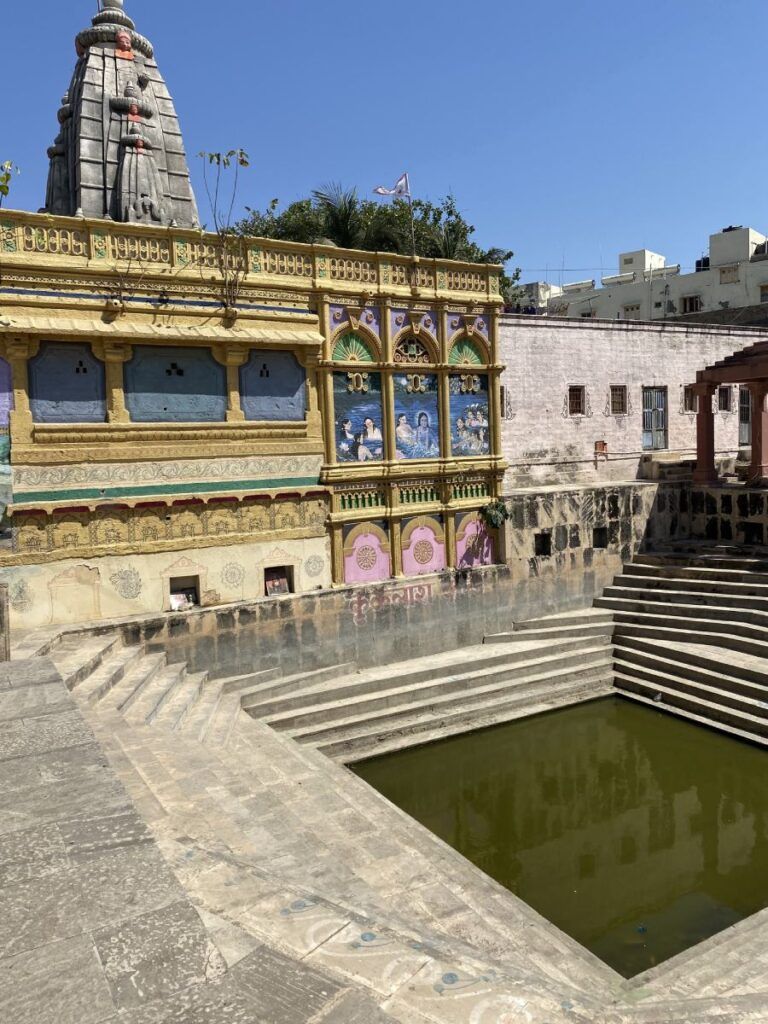
Architecture of Dwarkadhish Temple:
Chaulukya Style: The Dwarkadhish Temple is constructed in the Chaulukya style of architecture, which was prevalent in Gujarat during the medieval period. This architectural style is characterized by intricately carved stone structures and beautiful sculptures.
Five-Storied Structure: The temple is a five-story building with a spire rising to a significant height. The spire, also known as the shikara, is adorned with detailed carvings and sculptures.
Sandstone Construction: The temple is primarily constructed from sandstone, which is a common building material in the region. The intricate carvings on the sandstone walls and pillars showcase various mythological and religious motifs.
Entrances and Doorways: The Dwarkadhish Temple has multiple entrances and doorways, each with its own architectural significance. The main entrance, known as the Swarga Dwar (Heavenly Gate), is a massive doorway with detailed carvings. The entrance is flanked by two pillars that have sculptures of guards.
Central Hall: The main hall of the temple is known as the Jagat Mandir and is supported by 60 intricately carved pillars. The central deity, Lord Dwarkadhish, is enshrined in this hall. The idol of Lord Krishna is made of black marble and is adorned with jewelry and colorful garments.
Narrow Corridors: The temple has narrow, winding corridors with numerous small shrines and alcoves dedicated to various deities. Pilgrims can circumambulate the central sanctum through these corridors.
Exterior Sculptures: The exterior walls of the temple are adorned with intricate sculptures of gods, goddesses, and various scenes from Hindu mythology. These carvings are a testament to the skill and craftsmanship of the artisans of that era.
Gopuram: The main entrance gopuram (tower) is adorned with colorful artwork and religious motifs. It stands as a prominent and striking feature of the temple’s architecture.
Tank: The temple complex also includes a large tank called the Gomti Kund, which is considered sacred. Pilgrims often take a ritual bath in this tank before visiting the temple.
Explore More Temples>> Subramanya Swamy Temple at Pazhamudircholai – Murugan Temple
Specialty of Dwarkadhish Temple:
Here are some of the specialities of the Dwarkadhish Temple:
- It is one of the oldest and most important temples dedicated to Lord Krishna.
- It is believed to be the seventh incarnation of the city of Dwarka, which is mentioned in the Mahabharata and other Hindu scriptures.
- The temple is a magnificent structure with intricate carvings and a soaring spire.
- It is one of the four Char Dham pilgrimage sites in India, which are considered to be the most sacred places for Hindus.
- The temple is home to a four-armed idol of Lord Krishna, which is said to be very powerful and miraculous.
- The temple is a popular tourist destination and attracts millions of visitors every year.
Explore More Temples>> Char Dham Yatra – A Complete Guide to Spiritual Destination
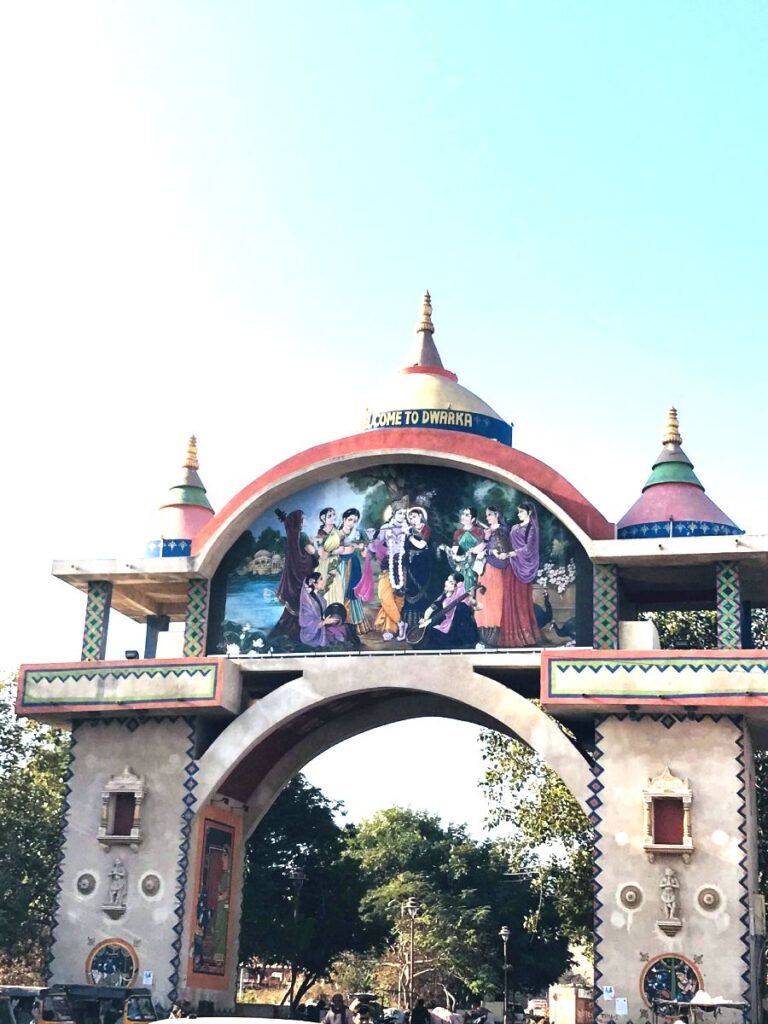
Mystery of Dwarkadhish Temple:
The temple is surrounded by a number of mysteries, one of the most intriguing of which is the possibility of a sunken city beneath the sea off the coast of Dwarka. According to Hindu mythology, the original city of Dwarka was built by Lord Krishna himself and was a magnificent and prosperous city. However, after Lord Krishna’s death, the city was submerged in the sea.
In recent years, archaeologists have discovered evidence that suggests that the myth of a sunken city of Dwarka may be true. In 2000, a team of archaeologists from the National Institute of Oceanography discovered a number of underwater ruins off the coast of Dwarka, including stone blocks, pillars, and artifacts. The ruins are believed to be from a city that was submerged in the sea around 3500 years ago, which corresponds to the time period when Lord Krishna is believed to have lived.
Another mystery of the Dwarkadhish Temple is the exact date of its construction. The current temple structure is believed to have been built in the 16th century, but there is evidence that suggests that there may have been an earlier temple on the same site. Some scholars believe that the original temple may have been built as early as the 2nd century BCE.
The Dwarkadhish Temple is also known for its unique architectural style. The temple is built in a combination of the Nagara and Dravidian styles of architecture. The temple has a seven-storyed shikhara (tower) and is decorated with a number of intricate carvings.
The Dwarkadhish Temple is a popular pilgrimage site for Hindus from all over the world. The temple is also a major tourist attraction. Visitors to the temple can admire the beautiful architecture, worship Lord Krishna, and learn about the mysteries of the sunken city of Dwarka.
Explore More Temples>> Swaminarayan Akshardham Temple, Delhi | Complete Guide
Secrets of Dwaraka:
Here are some of the secrets of Dwarka:
- The sunken city: According to Hindu mythology, the original city of Dwarka was submerged in the sea after Krishna’s death. In recent years, archaeologists have discovered evidence of a sunken city off the coast of Dwarka, including stone blocks, pillars, and artifacts. The ruins are believed to be from a city that was submerged in the sea around 3500 years ago, which corresponds to the time period when Krishna is believed to have lived.
- The Sudarshan Chakra: The Sudarshan Chakra is Krishna’s discus weapon, which is said to be extremely powerful and destructive. It is said that the Sudarshan Chakra is hidden somewhere in Dwarka. Some believe that it is hidden in the Dwarkadhish Temple, while others believe that it is hidden in the sunken city.
- The mysterious flute: Krishna is often depicted playing a flute. It is said that Krishna’s flute is still hidden somewhere in Dwarka. Some believe that it is hidden in the Dwarkadhish Temple, while others believe that it is hidden in the sunken city.
- The divine gates: Dwarka is said to have 72 divine gates. It is said that these gates are guarded by demigods and that they can only be opened by those who have pure hearts. Some believe that the divine gates are located in the sunken city, while others believe that they are located in the Dwarkadhish Temple.
These are just a few of the many secrets of Dwarka. The city is shrouded in mystery and intrigue, and it continues to fascinate people from all over the world.
In addition to the secrets listed above, here are some other interesting facts about Dwarka:
- Dwarka is one of the seven holiest cities in Hinduism, known as the Sapta Puri.
- Dwarka is believed to be the birthplace of the Dwarkadhish Temple, one of the most sacred Hindu temples in the world.
- Dwarka is also home to the Bet Dwarka island, which is home to a number of other Hindu temples, including the Jagat Mandir and the Rukmini Devi Temple.
- Dwarka is a popular pilgrimage site for Hindus from all over the world. The city is also a major tourist attraction, known for its beautiful beaches, temples, and culture.
Explore More Temples>> Brihadeeswarar Temple: Timeless Marvel of Chola Architecture
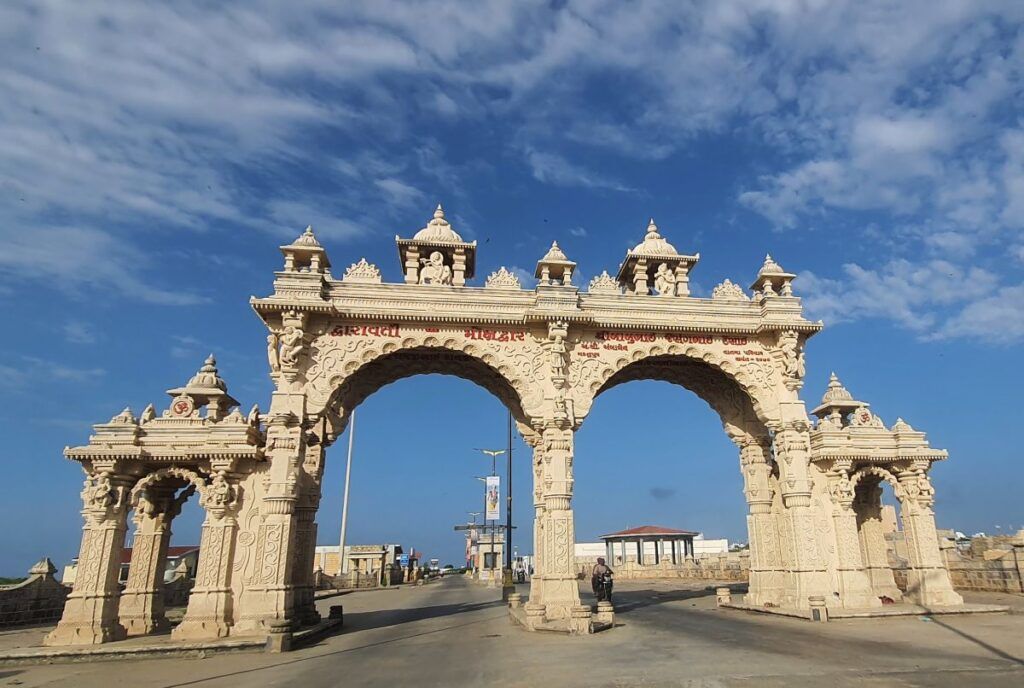
Archaeological findings in Dwaraka:
Archaeological findings in Dwarka have provided evidence of a continuous settlement from the late Bronze Age (c. 1500 BCE) to the present day. The most significant findings have been made in the submerged city of Dwarka, which is located about 500 meters off the coast of the modern city.
The submerged city of Dwarka covers an area of about 20 square kilometers and contains a variety of archaeological features, including:
- Stone walls and bastions: The submerged city is surrounded by a massive stone wall with bastions at regular intervals. The wall is believed to have been built to protect the city from attack.
- Wharves and jetties: The submerged city also contains a number of wharves and jetties, which indicate that it was a major port city.
- Artifacts: Archaeologists have discovered a variety of artifacts in the submerged city, including pottery, coins, beads, and other items. These artifacts suggest that the city was a wealthy and cosmopolitan center.
Radiocarbon dating of the artifacts from the submerged city suggests that it was inhabited between the 15th and 10th centuries BCE. This corresponds to the time period of the Mahabharata, in which Dwarka is described as a major city and the capital of the Yadava kingdom.
The exact cause of the submergence of the city is still unknown. However, scientists believe that it may have been due to a combination of factors, including rising sea levels, tectonic activity, and coastal erosion.
The findings in Dwarka have provided important insights into the ancient history of India and the development of urban centers in the region. The submerged city of Dwarka is a unique and important archaeological site that continues to reveal its secrets today.
In addition to the findings in the submerged city, archaeologists have also made significant discoveries at the Dwarkadhish Temple complex. These discoveries include:
- A fortified settlement: Archaeologists have discovered a fortified settlement dating back to the 2nd century BCE beneath the Dwarkadhish Temple complex. This settlement is believed to be the original city of Dwarka, founded by Lord Krishna himself.
- Temples and other religious structures: Archaeologists have also discovered a number of temples and other religious structures at the Dwarkadhish Temple complex. These structures date from a variety of periods, suggesting that the site has been a major religious center for centuries.
Explore More Temples>> Beyond Belief: Exploring India’s Top 10 Temples
Places to visit near Dwarkadhish Temple:
Beyt Dwarka (Bet Dwarka): This is an island located nearby, known for its temples and beautiful beaches. It’s believed to be the place where Lord Krishna resided in his younger days.
Nageshwar Jyotirlinga Temple: Located about 17 km from Dwarka, this temple is one of the 12 Jyotirlinga shrines dedicated to Lord Shiva.
Rukmini Temple: Situated 2 km away from the Dwarkadhish Temple, this temple is dedicated to Rukmini, the wife of Lord Krishna.
Gopi Talav: This is a historic tank associated with stories of Lord Krishna and the Gopis. It’s a serene spot for meditation and reflection.
Dwarka Beach: The beach near Dwarka is a pleasant place to relax and take a leisurely stroll, especially during the evenings when the sun sets.
Bhadkeshwar Mahadev Temple: This temple is located on the sea shore and offers stunning views of the Arabian Sea. It’s a great place to witness the beauty of the coastline.
Gomti Ghat: This is a sacred bathing ghat where pilgrims take a dip in the holy waters of the Gomti River before visiting the Dwarkadhish Temple.
Sudama Setu: It’s a bridge that connects the mainland with the pilgrimage spot of Beyt Dwarka, known for its religious significance.
Samudra Narayan Temple: Located near the Dwarkadhish Temple, this temple is dedicated to Lord Vishnu and is known for its impressive architecture and intricate carvings.
Dunny Point: It’s a scenic spot that offers panoramic views of the Arabian Sea and the surrounding landscape.
Gujarat Bird Sanctuary: Located about 15 km from Dwarka, this sanctuary is home to various bird species and is a great place for birdwatching.
Lighthouse at Dwarka: The lighthouse offers an excellent view of the Dwarka city and the Arabian Sea. You can climb to the top for a panoramic view.
Explore More Temples>> Arunachaleswara Temple: A Spiritual Experience of a Lifetime
FAQ:
Where is the Dwarkadhish Temple located?
The Dwarkadhish Temple is located in Dwarka, Gujarat, India. Dwarka is a coastal city on the Arabian Sea, about 300 kilometers from Ahmedabad.
What is the Dwarkadhish Temple dedicated to?
The Dwarkadhish Temple is dedicated to Lord Krishna, the eighth incarnation of Vishnu. Lord Krishna is believed to have founded the city of Dwarka and to have lived there for many years.
What is the history of the Dwarkadhish Temple?
The current temple structure is believed to have been built in the 16th century, but there is evidence that suggests that there may have been an earlier temple on the same site. Some scholars believe that the original temple may have been built as early as the 2nd century BCE.
What are the timings of the Dwarkadhish Temple?
The Dwarkadhish Temple is open from 6:30 AM to 9:30 PM. The temple is closed from 1:00 PM to 5:00 PM.
What are the rituals performed at the Dwarkadhish Temple?
The Dwarkadhish Temple is a major pilgrimage site for Hindus. Devotees come to the temple to worship Lord Krishna and to participate in the various rituals that are performed there. These rituals include pujas, aartis, and bhajans.
What are the dress codes for the Dwarkadhish Temple?
Dress codes for the Dwarkadhish Temple are as follows:
- Men are required to wear a dhoti or pyjama, and a shirt or kurta.
- Women are required to wear a saree, salwar kameez, or churidaar kurta.
- Shoes are not allowed inside the temple.
What are the facilities available at the Dwarkadhish Temple?
The Dwarkadhish Temple has a number of facilities available for visitors, including:
- A guesthouse
- A canteen
- A library
- A museum
- A parking lot
What are the tips for visiting the Dwarkadhish Temple?
Here are some tips for visiting the Dwarkadhish Temple:
- Dress appropriately.
- Remove your shoes before entering the temple.
- Be respectful of the temple and its customs.
- Follow the instructions of the temple staff.
What are the things to see and do in Dwarka?
In addition to the Dwarkadhish Temple, there are a number of other things to see and do in Dwarka, including:
- The Rukmini Devi Temple: This temple is dedicated to Rukmini, the wife of Lord Krishna.
- The Nageshwar Mahadev Temple: This temple is dedicated to Lord Shiva.
- The Somnath Temple: This temple is one of the twelve Jyotirlingas, or sacred shrines of Lord Shiva.
- The Gopi Talav: This lake is believed to be the site where Lord Krishna played with the gopis, or cowherd girls.
- The Bet Dwarka: This island is believed to be the original site of Dwarka.
Explore More Temples>> Enchanted Pashupatinath Temple: 5th Century Sacred Hindu Temple
How to reach Dwarkadhish Temple:
By Air:
The nearest airport to Dwarka is the Jamnagar Airport (approximately 130 kilometers away) and the Porbandar Airport (approximately 95 kilometers away). You can take a flight to either of these airports from major Indian cities and then proceed to Dwarka by road.
By Train:
Dwarka has a railway station, which is well connected to various cities in Gujarat and other parts of India. You can check the train schedules and book your tickets to Dwarka. The temple is located at a short distance from the railway station.
By Road:
Dwarka is accessible by road and is well connected through a network of highways. You can either hire a taxi or take a bus to Dwarka from major cities in Gujarat like Ahmedabad, Rajkot, Jamnagar, and Porbandar. The road journey offers picturesque views of the Gujarat landscape.
Local Transportation:
Once you reach Dwarka, you can hire an auto-rickshaw or a taxi to reach Dwarkadhish Temple. The temple is located in the heart of the city and is easily accessible.
Click to Visit official website of Dwarkadhish Temple. This website provides information about the temple, including its history, architecture, and religious significance. It also provides information about how to visit the temple, including opening hours, entry fees, and transportation options.

5 Comments